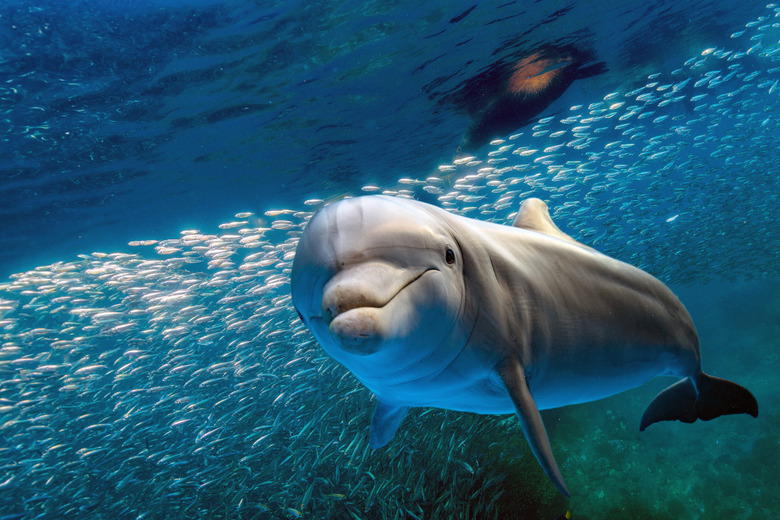How Do Dolphins Survive In Their Natural Habitat?
The toothed whales called dolphins rank among the most familiar marine mammals, long celebrated by humankind for their gracefulness, acrobatics and all-around braininess. Dolphins range in size from the little vaquita – an extremely endangered porpoise from the Gulf of California under 5 feet in length – to the mighty orca or killer whale, which may be 30 feet long and weigh more than 8 tons. Though there's a lot of physical and ecological variety among the dozens of species, these intelligent cetaceans share many basic adaptations that have helped them occupy a remarkable range of marine and freshwater habitats.
TL;DR (Too Long; Didn't Read)
The body shape, enhanced vision, echolocation ability and social success of dolphins helps these members of the toothed-whale suborder of cetaceans survive in their underwater habitat.
Dolphin Morphology: Sleek & Streamlined
Dolphin Morphology: Sleek & Streamlined
Dolphins and other whales are mammals, but with their hairless bodies and torpedo-like shape they've got more in common with fish. Millions of years of evolution have transformed dolphins from Indohyus, the terrestrial, four-legged hoofed mammals they descended from into spectacularly efficient swimmers. Their forelimbs serve as flippers, which help in steering; in place of hindlimbs, dolphins propel themselves with a muscle-packed tail and a boneless, horizontally oriented tail fin or fluke. Most dolphins sport a shark-like dorsal fin on their backs for stabilization, but some – such as the right whale dolphin and finless porpoise – seem to get by fine without them. Instead of nostrils on their snouts, dolphins respire through a blowhole atop their heads, which allows them to seamlessly incorporate breathing into their undulating swimming motion.
Dolphin Senses
Dolphin Senses
While dolphins' sense of taste seems to be on the weak side, many boast sharp underwater vision that, at least for some species such as the bottlenose dolphin, is likely stereoscopic. Some freshwater dolphins that forage in murky river depths, such as the boto, seem to have poor vision; the South Asian river dolphin of the Ganges-Brahmaputra and Indus drainages is basically blind. They can still effectively hunt, though, because all dolphins employ echolocation – a form of sonar – to find food: They emit high-frequency sounds focused by a fatty forehead organ called the melon; these clicks bounce off objects, and dolphins use the resulting echoes to pinpoint the location of prey. The cetaceans receive the echoes through tissue in their jawbone that transmits them to their inner ear.
Social Success
Most dolphins are extremely social animals: They often travel in pods of a dozen or two, and some species – such as striped and spinner dolphins – sometimes gather into "herds" or "superpods" numbering in the thousands. Living in groups allows for cooperative hunting, greater vigilance for – and, perhaps, occasional group defense from – predators such as large sharks and altruistic care for wounded or weak members of the pod. In communicating with one another to maintain social bonds and convey information, dolphins employ a rich range of vocalizations: chirps, squeals, whistles and others.
Versatile Hunters
Versatile Hunters
Echolocation, a complex brain and cooperative behavior allow dolphins to hunt prey through a variety of strategies. They often encircle schools of fish and force them toward the surface of the ocean, forming dense "bait balls" through which individual dolphins can dart to snap up meals. Dolphins will also drive fish into shallow waters for easier hunting; in some areas, they do so in cooperation with human fishermen. Bottlenose dolphins also entrap fish in "nets" of expelled bubbles. Orcas, the ocean's foremost apex predators – though popularly called killer whales, these creatures are really dolphins – employ a remarkable range of hunting methods. For example, orcas create waves to knock seals and penguins off floating ice floes, slide up onto beaches to snatch fur seals and seem to flip over sharks and rays before killing them to induce the temporary paralysis, called "tonic immobility," which those fish experience when upside down.
References
- The Sierra Club Handbook of Whales & Dolphins; Stephen Leatherwood, Randall R. Reeves
- NOAA Fisheries: Marine Mammal Laboratory — What Do You Know About Toothed Whale Echolocation?
- Whales of the World; Spencer Wilkie Tinker
- NOAA Fisheries: Bottlenose Dolphin (Tursiops Truncatus)
- Antarctic Peninsula Killer Whales Hunt Seals & a Penguin on Floating Ice; Ingrid N. Visser, et al.; Marine Mammal Science
- Earth Touch News: Watch: Orcas' Upside-Down Hunting Moves May Be a Cleaver Way to "Zombify" Stingrays
- Discover: Whales Evloved From Small Aquatic Hoofed Ancestors
Cite This Article
MLA
Shaw, Ethan. "How Do Dolphins Survive In Their Natural Habitat?" sciencing.com, https://www.sciencing.com/do-dolphins-survive-natural-habitat-8591990/. 19 April 2018.
APA
Shaw, Ethan. (2018, April 19). How Do Dolphins Survive In Their Natural Habitat?. sciencing.com. Retrieved from https://www.sciencing.com/do-dolphins-survive-natural-habitat-8591990/
Chicago
Shaw, Ethan. How Do Dolphins Survive In Their Natural Habitat? last modified March 24, 2022. https://www.sciencing.com/do-dolphins-survive-natural-habitat-8591990/
